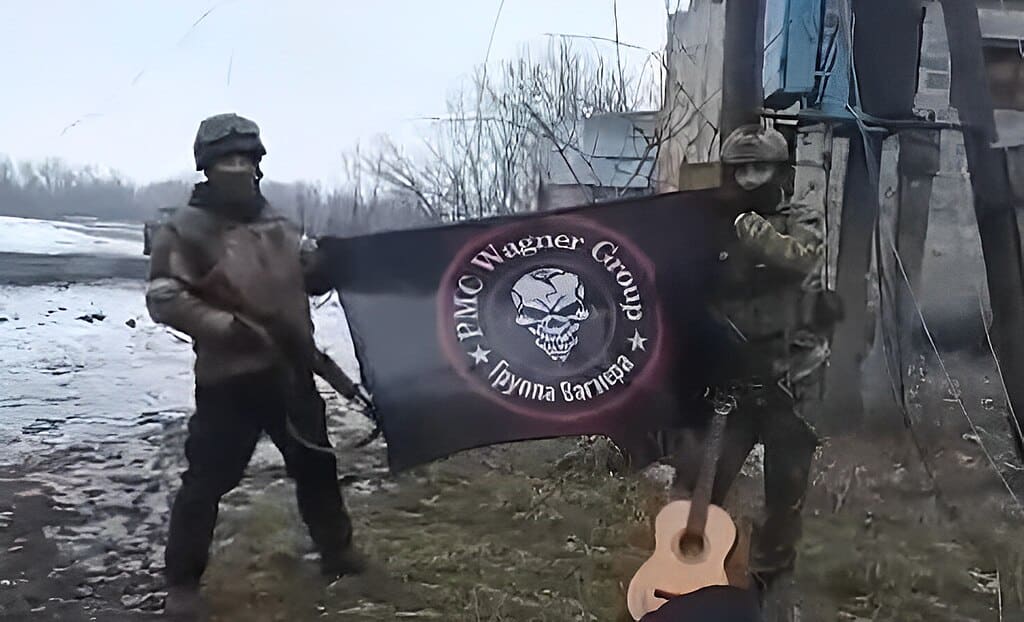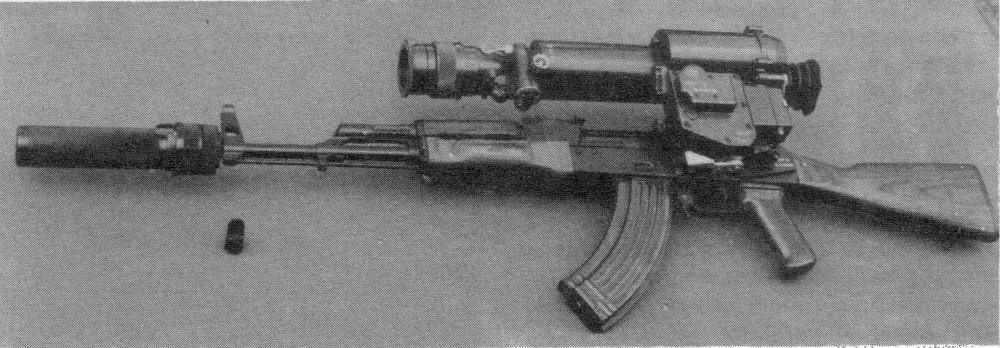Amidst the shadows of geopolitical intrigue and covert operations, a foreign private military group, the Wagner Group, stepped out of the shadows.
Wrapped in secrecy and alliances blurring the line between state and hired guns, the Wagner Group has made its mark on the global stage of conflict.
In the world of covert warfare, the Wagner Group is more than just another PMC (Private Military Company); it symbolizes shady covert tactics and powerful weaponry.

RELATED – Band of Brothers: The Wagner Group and the Russian State
Weapons and Gear of the Wagner Group
Not much is known about the exact weapons they use due to the clandestine nature of their work. But, due to photos emerging of Wagner Group militants in various parts of the world, we can more or less get a glimpse into what they are using.
Small Arms
- Assault Rifles: AK-47, AK-74, and variants
- Sniper Rifles: SVD Dragunov, various designated marksman rifles
- Machine Guns: PKM, RPK
- Handguns: Makarov 9×18 and Yarygin MP-443 Grach
Assault Rifles
The Wagner Group’s selection of AKM and AK-74 rifles as their battle rifles is likely attributed to the rifles’ renowned reliability and versatility.
The AKM is an upgraded version of the original AK-47 rifle. Known for its ruggedness and simplicity, the AKM’s design allows it to function effectively in various conditions, making it suitable for paramilitary operations.
Its 7.62x39mm cartridge provides sufficient stopping power, and its easy maintenance suits the Wagner Group’s potential need to operate in resource-constrained environments.

A few Wagner Group AKMs have been seen suppressed with the Russian PBS-1 Suppressor.
Designed for the AKM series of rifles and chambered in 7.62x39mm, the PBS-1 suppressor offers significant sound reduction without sacrificing the rifle’s reliability.

The Wagner Group’s choice of the PBS-1 suppressor aligns with their paramilitary activities, where maintaining a low profile and minimizing noise signature is crucial.
By equipping their AKMs with suppressors like the PBS-1, the Wagner Group can operate more discreetly, reducing the risk of detection during covert operations, ambushes, or other tactical exercises.
The AK-74, chambered in 5.45x39mm, offers a more modern variant with reduced recoil and increased accuracy compared to its predecessor. Using a smaller cartridge allows soldiers to carry more ammunition, enhancing their operational endurance.
The AK-74’s design evolution aligns with the Wagner Group’s potential preference for updated weaponry.

Both rifles are used extensively around the globe, making ammunition and spare parts more accessible.
This, coupled with their proven track record in combat, makes the AKM and AK-74 logical choices for a paramilitary group like the Wagner Group, which may engage in diverse and dynamic conflict scenarios.
Want to add an AK-74 to your collection? Guns.com has a few for sale.
Sniper Rifles
The Wagner Group likely chose the SVD Dragunov, a Soviet-designed semi-automatic sniper rifle, due to its historical reliability and effectiveness.

With origins dating back to the late 1950s, the SVD offers a balance of accuracy and rapid follow-up shots through its semi-automatic action. This feature suits the dynamic nature of modern conflicts, allowing snipers to engage targets quickly and maintain situational awareness. Its 7.62x54mmR cartridge provides good stopping power and range.
While the SVD Dragunov may not be the most modern option, its proven performance and rugged design make it suitable for various combat environments. The Wagner Group’s involvement in conflicts across different regions could necessitate a weapon with wide adaptability.
Despite its aging design, the SVD remains viable for designated marksmen and snipers, aligning with the Wagner Group’s operational needs.
Machine Guns
The Wagner Group’s adoption of the RPK-74 and PKM machine guns is likely based on their effectiveness, firepower, and adaptability in various combat environments.
The RPK-74 is a light machine gun chambered in 5.45x39mm, sharing ammunition with the AK-74 rifles. This commonality simplifies logistics and ammunition supply for the Wagner Group. The RPK-74’s intermediate cartridge balances controllable recoil with increased effective range compared to larger caliber machine guns.
Its bipod and extended barrel enhance accuracy during sustained fire, making it suitable for suppressing enemy positions and supporting fire for maneuvering units.

The PKM is a general-purpose machine gun chambered in 7.62x54mmR. Renowned for its reliability and firepower, the PKM offers a higher caliber round that delivers greater stopping power at the cost of increased recoil.
The weapon’s design allows for accurate fire at longer ranges, effectively engaging enemy personnel and light vehicles. The PKM’s versatility aligns with the Wagner Group’s operational diversity, from sustained fire roles to mobile engagements.

Both machine guns are widely used and recognized, ensuring the availability of ammunition and spare parts in conflict zones.
Their combination of firepower, portability, and adaptability to different combat scenarios makes the RPK-74 and PKM logical choices for the Wagner Group, which may require effective suppression and support capabilities in its operations.
Handguns
The Wagner Group’s potential use of the Makarov pistol and Yarygin pistol as sidearms could be attributed to their reliability, compactness, and familiarity. Most of Wanger Group’s ranks come from Russian Special Forces, which are extensively used on both platforms. It only makes sense that they would use them.
The Makarov pistol, chambered in 9x18mm, is a Soviet-era design known for its simplicity and durability. Its compact size makes it easy to carry, and its design ensures functionality even in adverse conditions.
The Makarov’s widespread use across various armed forces and paramilitary groups means that ammunition and spare parts are widely available, which is crucial for a group like the Wagner Group operating in diverse regions.
Guns.com has a few Makarov pistols for sale for ~$598.99.

The Yarygin pistol, formally known as the MP-443 Grach, is a modern Russian handgun designed for law enforcement and military use. Available in various calibers, including 9x19mm, it offers enhanced ergonomics and a higher magazine capacity than the Makarov.
The Yarygin’s modern design features, ambidextrous controls, and accessory rail make it a versatile choice for operatives who might need to carry concealed on low-vis operations or on a battle belt in overt tactical engagements.

Both pistols share a reputation for reliability, which is critical for a sidearm in combat scenarios. The choice between the Makarov and Yarygin might depend on the Wagner Group’s preference for modern features, ammunition compatibility, and the specific operational context.
According to a Russian Military officer, the Spetznaz SSO (Special Operation Forces) has Glock 17s in its inventory.
The Russian Spetsnaz SSO (Special Operations Forces) is a specialized branch of the Russian military focused on conducting high-level covert operations, counter-terrorism activities, and unconventional warfare.
Established in 2013, the Spetsnaz SSO brings together personnel from various branches of the Russian armed forces, including ground forces, navy, and airborne troops.
Body Armor
Identifying what body armor the Wagner Group is using is pretty difficult, but we were able to nail down the body armor that the Russian Spetznaz and FSB teams use; Fort Defender-1 and Defender-2 body armor (The FORT Defender-2 body armor, sometimes shortened to D2, is a heavy armor vest of Russian origin).
Since many of Wagner’s ranks come from these units, it’s highly likely that they wearD2 body armor.
The following video shows Wagner Group members testing their rifles against Ukrainian body armor. They are dumbfounded by how well it performs.
What’s Next For The Wagner Group
Following Yevgeny Prigozhin’s (Wagner Group Leader) reported death, the future of the Wagner Group, a private military company, remains uncertain.
Prigozhin transformed the group from mercenaries into a formidable military force. Speculation surrounds who will succeed his leadership. There’s a possibility that someone with ties to Russia’s military intelligence service, the GRU, might assume control.
While Prigozhin’s death marks a significant development, the group’s activities and role in international conflicts will likely continue, albeit potentially with leadership changes and strategic adjustments.
The Wagner Group’s next steps will depend on internal dynamics and, more importantly, what Putin wants to do.
For more information on what’s next for the Wagner Group, check out this article from ForeignPolicy.com.






Leave a Reply
Your email address will not be published. Required fields are marked *